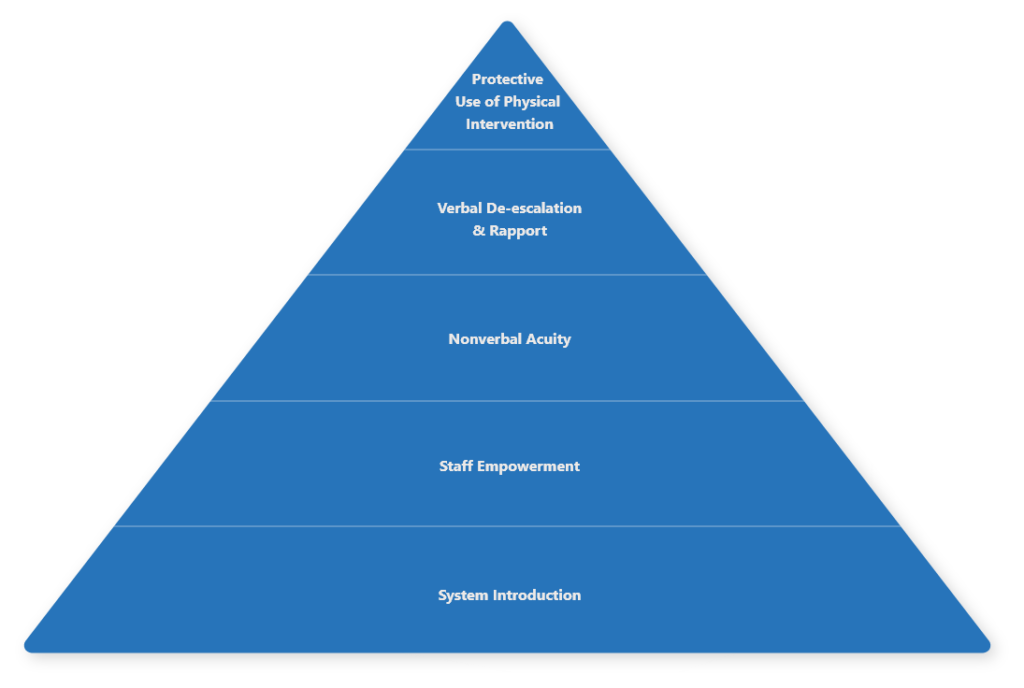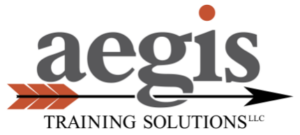Creating a New Standard for Safety and Best Practice.
The Aegis System™ was developed with a clear focus on solutions at point of care. Many of these practices transcend moments of acute crisis and positively impact day-to-day interactions.

The Aegis System™ has a tertiary learning design that will meet the needs of any organization.

M1. Aegis Introduction
Participants will acquire the foundational knowledge that The Aegis System™ is built upon.
M2. Staff Empowerment
Participants will learn to manage their own stress levels to mitigate the chance of overreacting or underreacting during crisis intervention. This is a critical factor in maintaining a safe workplace. This stress inoculation will enable professionals to maintain safety-oriented thinking while under duress.
M3. Nonverbal Acuity
Participants will learn about the important role that nonverbal communication has in crisis intervention. This acuity will also support unique intervention strategies. Professionals will learn how to present themselves to an escalated person and to maintain a non-threatening presentation.
M4. Verbal De-escalation & Rapport
Professionals will learn to evade and escape unwanted contact using techniques that are appropriate for a clinical environment. For organizations utilizing benevolent restraint, participants will learn to use Aegis Holds which are arranged in a tertiary design (maintaining the least restrictive option) to ensure a safe outcome. Each trained professional is educated on the risk of restraint and is expected to maintain safety-oriented decision-making at all times.
M5. Protective Use of Physical Intervention
The Aegis System™ is a rapport-based de-escalation model. Participants will learn an applied-empathy process and a skills-based approach that utilizes rapport to achieve de-escalation.
Aegis Prioritizes Safety Above All Else
The clear focus is on nonphysical de-escalation strategies that prevent behavioral escalation. Physical intervention is always a last resort used only when the risk of not intervening is greater.
Aegis techniques are arranged in a tertiary design that is consistent with employing the least restrictive option. Aegis Holds are used only in response to an imminent safety threat. All Aegis physical intervention techniques are classified as benevolent and meet the following levels of acceptability.
Kinesics Review
Each technique is reviewed by a team of doctors. Static and dynamic loading is factored.
Experience Based
The technique has been proven in real conditions.
Intervention Guidelines
Aligns with all available guidelines and standards.
Benevolent Intent
Each technique is designed to provide safety and to enable the continuation of a therapeutic process.
Transferable
Each technique is determined to be transferable through established methodology for teaching motor skills.
Margin for Error
Despite significant measures taken to ensure the fidelity of instructed techniques, there is a margin for error under duress. Incorrect application of techniques under duress is reasonably anticipated.
Exertion
The level of exertion required to achieve and/or maintain each technique is factored.
The Aegis Safety Position™ – a proprietary technique that is revolutionizing best practice.
Aegis Holds are used to achieve this seated safety position. The Aegis Safety Position™ is highly adaptable to medical equipment, hospital beds, and escorting. This position safeguards against any type of airway restriction and complications from head, arm, and leg thrashing. The safety and effectiveness of the Aegis Safety Position™ is unequaled and is supported by real-world experience and empirical findings.
The Aegis Safety Position™ eliminates the need for prone or supine floor restraints. Although prone restraint is prohibited or restricted in most states, other training providers still use it as part of their curriculum. Supported by recent policy scan, and due to empirical findings, Aegis believes prone restraints are dangerous and should not be taught.

Benefits of the Aegis Safety Position™
Minimally invasive position that offers respect and dignity to an escalated person
Leads to shorter duration of incidents
Not only classified as benevolent but also appears benevolent to a third-party observer
Easily integrated and taught in any clinical environment
Learn more about our position on avoiding prone restraint:
